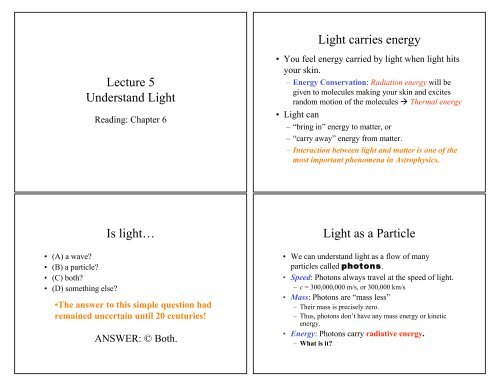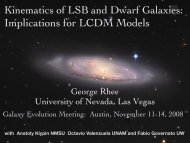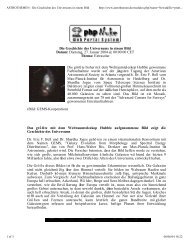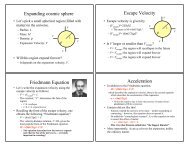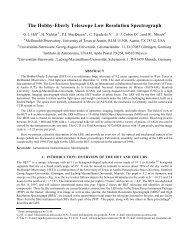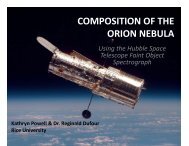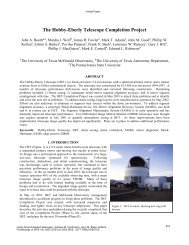You also want an ePaper? Increase the reach of your titles
YUMPU automatically turns print PDFs into web optimized ePapers that Google loves.
• (A) a wave?<br />
• (B) a particle?<br />
• (C) both?<br />
• (D) something else?<br />
Lecture 5<br />
Understand Light<br />
Reading: Chapter 6<br />
Is light…<br />
•The answer to this simple question had<br />
remained uncertain until 20 centuries!<br />
ANSWER: © Both.<br />
Light carries energy<br />
• You feel energy carried by light when light hits<br />
your skin.<br />
– Energy Conservation: Radiation energy will be<br />
given to mo<strong>lec</strong>ules making your skin and excites<br />
random motion of the mo<strong>lec</strong>ules ! Thermal energy<br />
• Light can<br />
– “bring in” energy to matter, or<br />
– “carry away” energy from matter.<br />
– Interaction between light and matter is one of the<br />
most important phenomena in Astrophysics.<br />
Light as a Particle<br />
• We can understand light as a flow of many<br />
particles called photons.<br />
• Speed: Photons always travel at the speed of light.<br />
– c = 300,000,000 m/s, or 300,000 km/s<br />
• Mass: Photons are “mass less”<br />
– Their mass is precisely zero.<br />
– Thus, photons don’t have any mass energy or kinetic<br />
energy.<br />
• Energy: Photons carry radiative energy.<br />
– What is it?
Radiative Energy<br />
• All photons have the same speed.<br />
• Photons don’t have any mass.<br />
• Do these facts imply that all photons have<br />
the same radiative energy? No.<br />
• To understand the radiative energy, we<br />
need to think of light as waves.<br />
• For a wave, its speed:<br />
– s = f !<br />
– f is frequency<br />
– ! is wavelength<br />
• But the speed of light is a<br />
constant, c.<br />
• For light:<br />
– f ! = c<br />
• The higher f is, the<br />
smaller ! is, and vice<br />
versa.<br />
• Our eyes recognize f (or !)<br />
as color!<br />
Light as a Wave<br />
• Key concepts<br />
– Wavelength<br />
measured in<br />
length<br />
– Frequency<br />
measured in<br />
“hertz”<br />
Light as a Wave<br />
What is Radiative Energy?<br />
• Every photon has the radiative energy,<br />
which is proportional to its frequency, f:<br />
–E photon = h f<br />
– h is Planck’s constant<br />
= 6.6x10 -34 joule x sec.<br />
• Or, inversely proportional to its<br />
wavelength, !<br />
–E photon = h c/!<br />
• Light was thought to be a wave until<br />
Planck and Einstein discovered that it<br />
also behaves as a particle with the<br />
energy given above. (Planck, 1990;<br />
Einstein, 1902).
Radiative Energy and Spectrum:<br />
Why UV Radiation is an Enemy!<br />
• Bluer light carries more energy; thus, UV radiation<br />
damages skins more badly than the visible light. X-rays<br />
and gamma-rays can be dangerous!<br />
• On the other hand, IR radiation carries less energy, and<br />
radio waves are very low energy.<br />
Emission and Absorption<br />
• Emission lines and absorption lines are golden<br />
tools of Astronomy<br />
• Specific atoms, such as hydrogens or carbons,<br />
emit or absorb photons with specific energy (i.e.,<br />
specific wavelength).<br />
• Therefore, from those lines, we can tell what<br />
elements emitted or absorbed the photons.<br />
Light and Matter<br />
• Light can be<br />
– Emitted,<br />
– Absorbed,<br />
– Transmitted, or<br />
– Ref<strong>lec</strong>ted<br />
by matter.<br />
• This “interaction” between matter and light leaves<br />
fingerprints of matter in light.<br />
– By measuring properties of light, we can learn about<br />
the matter that has interacted with the light we observe.<br />
– Astronomy!<br />
Thermal Radiation<br />
• Not just lines! There are“continuous emission”<br />
spectra.<br />
• One example is thermal radiation.<br />
– Imagine gas in which atoms are moving randomly.<br />
– If the gas is thin (or transparent), then the atoms in the<br />
gas emit or absorb photons only once or twice,<br />
resulting in lines.<br />
– If the gas is dense (or opaque), then the atoms in the<br />
gas emit and absorb photons frequently.<br />
– The random motion of the atoms “smear out” the line<br />
features, resulting in a characteristic continuous<br />
spectrum, called the black-body spectrum.<br />
• The shape of the black-body spectrum is<br />
determined only by temperature --> we can use<br />
this fact to determine temperature of the gas.
1. Hotter objects emit<br />
more total radiation<br />
per unit surface area.<br />
" Stephan-Boltzmann<br />
Law<br />
" Energy per area = "T 4<br />
¬ " is the Stefan-<br />
Boltzmann constant<br />
= 5.7x10 -8 Watts/(m 2 K 4 )<br />
2. Hotter objects emit<br />
bluer photons (with a<br />
higher average<br />
energy.)<br />
" Wien Law<br />
¬ ! max = 2.9 x 10 6 / T(K)<br />
[nm]<br />
The Doppler Effect<br />
Black Body<br />
1. Light emitted from an object moving towards<br />
you will have its wavelength shortened.<br />
BLUESHIFT<br />
2. Light emitted from an object moving away from<br />
you will have its wavelength lengthened.<br />
REDSHIFT<br />
3. Light emitted from an object moving<br />
perpendicular to your line-of-sight will not<br />
change its wavelength.<br />
The Doppler Effect
The Doppler Effect<br />
#! v<br />
=<br />
! c<br />
• We can measure the<br />
Doppler shift of emission<br />
or absorption lines in the<br />
spectrum of an<br />
astronomical object.<br />
• We can then calculate the<br />
velocity of the object in<br />
the direction either<br />
towards or away from<br />
Earth. (radial velocity)<br />
Measuring Radial Velocity<br />
Measuring Rotational Velocity Redshift & Expansion of the<br />
Universe<br />
• Since the Universe is expanding, most of<br />
galaxies are moving away from us.<br />
• Their emission and absorption lines are<br />
redshifted.<br />
• The amount of redshift is larger for more<br />
distant galaxies --> redshift can be used as a<br />
distance indicator.
Next Lecture: The Solar System!<br />
Reading: Chapter 8<br />
•Before next <strong>lec</strong>ture: Don’t forget to put your<br />
homework in the box before you come into<br />
this room. No homework will be accepted<br />
after the class!<br />
•Today: Don’t forget to pick up your quiz<br />
from the box before you leave this building.


